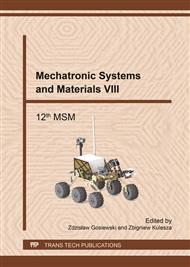[1]
Narcis Ursache, Tomas Melin, Askin Isikveren, and Mike Friswell. Morphing Winglets for Aircraft Multi-Phase Improvement. In 7th AIAA ATIO Conf, 2nd CEIAT Int'l Conf on Innov & Integr in Aero Sciences, 17th LTA Systems Tech Conf; followed by 2nd TEOS Forum, Aviation Technology, Integration, and Operations (ATIO) Conferences. American Institute of Aeronautics and Astronautics, September 2007. URL http: /dx. doi. org/ 10. 2514/6. 2007-7813.
DOI: 10.2514/6.2007-7813
Google Scholar
[2]
Johannes Scheller, Gurvan Jodin, Karl-Joseph Rizzo, Jean François Rouchon, Eric Duhayon, Michael Triantafyllou, and Marianna Braza. A combined smart-materials approach for next-generation airfoils. Solid State Phenomena, (2016).
DOI: 10.4028/www.scientific.net/ssp.251.106
Google Scholar
[3]
F.T. Calkins, J.H. Mabe, Shape Memory Alloy Based Morphing Aerostructures, Journal of Mechanical Design (2010) Vol. 132 111012.
DOI: 10.1115/1.4001119
Google Scholar
[4]
C. Lexcellent, Shape-memory Alloys Handbook, Wiley-ISTE, March 2013, ISBN: 978-1-84821-434-7.
Google Scholar
[5]
Johannes Scheller, Maxime Chinaud, Jean-Francois Rouchon, Eric Duhayon, Sebastien Cazin, Moise Marchal, and Marianna Braza. Trailing-edge dynamics of a morphing NACA0012 aileron at high reynolds number by high-speed PIV. Journal of Fluids and Structures, 55: 42 – 51, (2015).
DOI: 10.1016/j.jfluidstructs.2014.12.012
Google Scholar
[6]
Dana M Elzey, Aarash YN Sofla, and Haydn NG Wadley. A bio-inspired high-authority actuator for shape morphing structures. In Smart structures and materials, pages 92–100. International Society for Optics and Photonics, (2003).
DOI: 10.1117/12.484745
Google Scholar
[7]
André Musolff. Formgedaechtnislegierungen. PhD thesis, Technische Universitaet Berlin, Uni- versitaetsbibliothek (Diss. -Stelle), (2005).
Google Scholar
[8]
Justin Manzo and Ephrahim Garcia. Demonstration of an in-situ morphing hyperelliptical cambered span wing mechanism. Smart Materials and Structures, 19(2): 025012, 2010. URL http: /stacks. iop. org/0964-1726/19/i=2/a=025012.
DOI: 10.1088/0964-1726/19/2/025012
Google Scholar
[9]
Pankonien, A.M., Duraisamy, K., Faria, C.T. and Inman, D.J., 2014. Synergistic smart morphing aileron: aero-structural performance analysis. Chapter. doi, 10(2514), p.6.
DOI: 10.2514/6.2014-0924
Google Scholar
[10]
Pankonien, A.M., 2015. SMART MATERIAL WING MORPHING FOR UNMANNED AERIAL VEHICLES (Doctoral dissertation, University of Michigan).
Google Scholar
[11]
Mohammad Elahinia. Effect of system dynamics on shape memory alloy behavior and control. PhD thesis, Virginia Tech, (2004).
Google Scholar
[12]
Jérôme Duval. Conception et mise en oeuvre d'un système d'actionneurs AMF répartis pour le contrôle de forme électroactif de voilures aéronautiques. PhD thesis, Institut National Polytechnique de Toulouse, (2005).
Google Scholar
[13]
J. Jayender, R. V. Patel, S. Nikumb and M. Ostojic, Modelling and gain scheduled control of shape memory alloy actuators, Proceedings of 2005 IEEE Conference on Control Applications, 2005. CCA 2005., Toronto, Ont., 2005, pp.767-772.
DOI: 10.1109/cca.2005.1507221
Google Scholar
[14]
Featherstone, Roy, and Yee Harn Teh. Improving the speed of shape memory alloy actuators by faster electrical heating., Proceedings of the Ninth International Symposium on Experimental Robotics. (2004).
DOI: 10.1007/11552246_7
Google Scholar
[15]
Kim, Hongjip, et al. Sensorless displacement estimation of a shape memory alloy coil spring actuator using inductance., Smart Materials and Structures 22. 2 (2012): 025001.
DOI: 10.1088/0964-1726/22/2/025001
Google Scholar
[16]
Ma, N., G. Song, and H. J. Lee. Position control of shape memory alloy actuators with internal electrical resistance feedback using neural networks., Smart materials and structures 13. 4 (2004): 777.
DOI: 10.1088/0964-1726/13/4/015
Google Scholar


